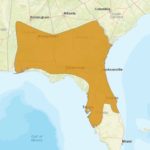Most people in Florida have never seen – or even heard – of pocket gophers, but these incredibly cute animals play an important role in our state’s ecosystems.
Slightly larger than a guinea pig, pocket gophers prefer long-leaf pine habitats. They dig tunnels – some up to 500 feet long – which aerate tree roots and make nutrients more available for above-ground plants and trees. Like gopher tortoises, their tunnels also shelter a wide variety of other animals including pine snakes (which eat the pocket gophers if they can catch them), lizards, frogs, insects and amphibians including the very-rare mole skink. While it’s unlikely for people to see the gophers, you can identify where they’ve been by the presence of their distinct soil mounds composed of material removed from their burrows. Ironically, though the pocket gophers are herbivores, they actually increase productivity and plant diversity in areas where they are found, along with increasing species diversity by providing habitats in their tunnels.

“We like to call them ecosystem engineers because their activity changes what goes on around them,” says Sarah Duncan, a post-doctoral research associate at the University of Florida leading the pocket gopher research. “They increase plant diversity because they also hide roots and seeds in caches where they can eat them when nothing else is available, but like squirrels and the acorns they bury, many of those roots and seeds actually propagate.”
As their traditional habitat shrinks in the face of ongoing development, scientists with the Florida Fish and Wildlife Conservation Commission’s (FWC) have partnered with other agencies and universities from Georgia and Alabama to investigate what pocket gophers need to survive, through Florida’s State Wildlife Grant program.
Although no one knows how many pocket gophers remain in Florida, they’re listed as threatened in southern Alabama and Georgia, which is the northern extent of their range. “We don’t know exactly what they need to move in,” Duncan said. “We find them in long-leaf pine forests, but we also see them in grassy areas next to gas stations. We need to know what the repercussions are when they move into more urban areas.”
While their importance to their ecosystem is impressive, these gophers may create a nuisance where they inhabit lab near humans. A quick onling search for pocket gophers yields multiple ways to kill them because the sandy mounds they create mar the appearance of manicured lawns and golf courses. The mounds, she adds, are the closest most people will ever come to seeing a pocket gopher because they spend most of their lives underground.
 Students from the universities of Florida, Alabama and Georgia, as well as scientists from UF and the FWC, are tracking down pocket gopher populations with help from citizen-scientists who report sightings on an iNaturalist website. “They seem to live in very patchy populations and if you’re really lucky you might see one eating plants just at the end of the tunnel,” Duncan notes. Like gopher tortoises, the prefer foraging on younger plants, like that spring up after a fire or prescribed burn.
Students from the universities of Florida, Alabama and Georgia, as well as scientists from UF and the FWC, are tracking down pocket gopher populations with help from citizen-scientists who report sightings on an iNaturalist website. “They seem to live in very patchy populations and if you’re really lucky you might see one eating plants just at the end of the tunnel,” Duncan notes. Like gopher tortoises, the prefer foraging on younger plants, like that spring up after a fire or prescribed burn.
Sightings of gopher tortoise mounds, which resemble small gopher tortoise mounds, are logged into a database. A report expected at the end of 2018 will provide specific management recommendations on protecting habitat, maintaining connectivity among populations and reintroducing them into appropriate areas.
Until more is known about their habitat needs, there is little most people can do to help protect them, other than avoiding the use of pesticides and herbicides.
This is the first of a series on little-known animals identified by the Florida Wildlife Legacy Initiative (part of the FWC) as species of greatest conservation need in the State Wildlife Action Plan. The initiative is primarily funded through the State and Tribal Wildlife Grants Program with matching resources from conservation partners. It is the only federal program with the explicit goal of preventing animals from being placed on the federal endangered species lists. Upcoming articles will look at reddish egrets, diamondback terrapins, spiny sea urchins and sandhill cranes.
Originally published Oct. 23, 2017.
Save
